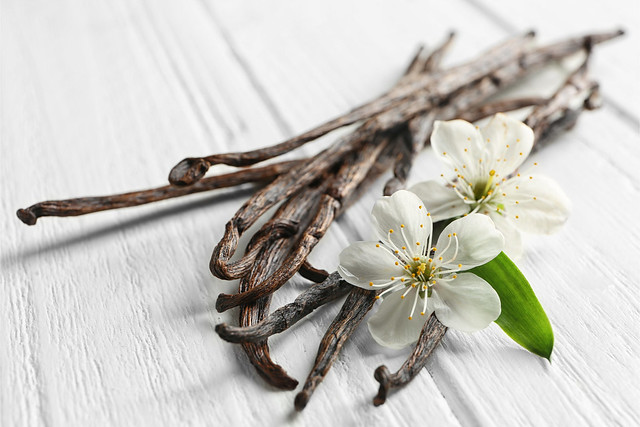The word vanilla is sometimes used for things that are boring, blah or basic. However, true food lovers know that vanilla is anything but plain. Its complex flavor profile, laborious growing process and interesting history all contribute to what makes this spice so intriguing.
About
It grows as a vine and can be up to 300 feet long. The vine features pale green-yellow flowers that, when pollinated, grow a fruit that looks like a string bean. It takes about nine months for a vanilla pod to ripen, and then it must undergo a long and tedious curing process. The little specks that you can see in high-quality vanilla bean ice cream are the tiny black speeds that fill vanilla pods.History
Vanilla is native to South and Central America. The Totonacs are credited for first harvesting vanilla, but its production was taken over by the Aztecs when they conquered the Totonacs, and then the Spanish when they conquered the Aztecs. The Spanish brought both vanilla and cacao back to Europe where it was grown in gardens, but the vanilla never produced fruit. Later they learned that this is because the Melipona bee was needed to pollinate the flowers, but that species didn’t live in Europe. Years later on the island of Reunion, a tedious technique for hand-pollinating the flower was discovered, making Reunion and its neighboring island, Madagascar, very popular for their vanilla industry. About 75 percent of vanilla today still comes from Madagascar or Reunion. Up until the 17th century, vanilla was mostly just used as an additive for drinking chocolate. It wasn’t until the 1780s that the French began using vanilla to flavor ice cream, a recipe created by Thomas Jefferson. By the late 1800s, vanilla was in high demand, partially in thanks to its use in cola beverages.Harvesting
Vanilla is the second most expensive spice in the world due to its labor-intensive production. The vast majority of vanilla that is sold in today’s marketplace is hand-pollinated. Growers must be very skilled in order to do this, as the flowers only have about one to two days in their growth cycle in which they can be pollinated, otherwise they will wither and die. After harvesting, the beans go through a tedious curing process that consists of alternating between sun drying during the day and sweating at night for up to thirty days. The entire process, from planting the seed to the finished product, takes about one year. It takes around five to seven pounds of vanilla beans to create one pound of processed vanilla. All of this contributes to vanilla’s high cost of about $300 per pound.Vanilla vs. Vanillin
Because of its high cost, 99% of vanilla-flavored products on the market don’t contain vanilla. Vanilla is made up of about 250 chemical compounds that contribute to its flavor. The most significant component of vanilla’s fragrance is vanillin, a compound that is fairly easy to create artificially and is about twenty times less expensive. Most vanilla extracts that you find in the grocery store are made with vanillin, unless they say “pure vanilla extract”. Vanillin isn’t unhealthy or dangerous to consume, and it does taste extremely similar, however, its flavor is not as strong or as complex as pure vanilla extract.How To Add Farm Stand Products to Your Delivery:
CSA members - head on over to our online Farm Stand Market to customize your upcoming delivery. Market is open from noon on Thursday until 6 pm, 2 days before your scheduled delivery day. After you confirm your produce items, click the orange button "Confirm and Continue To Other Farm Products" to add the products to your delivery.
Not part of our farm family? Find out if we deliver to your neighborhood. You can even get your whole office in on the fun with our office snack packs. Find more information about our office deliveries here.



